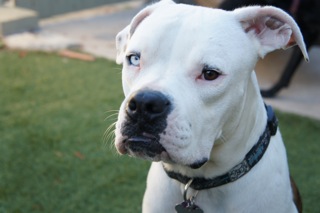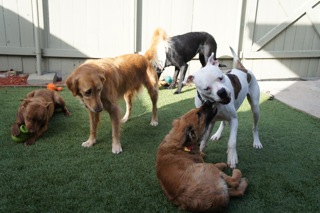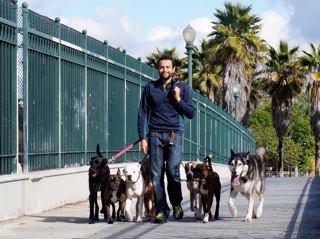After weeks or months of planning and consideration, you made the decision to get another dog. Two dogs are as easy to take care of as one dog, if your first dog has been well trained and will model good dog-manners to the new dog. However, adding a second canine to the household is financially more expensive and requires more time (in terms of training, feeding, walking, and picking up after your dogs), and may reveal underlying behavioral problems in your dog. As a multiple dog household, we encourage people that are ready for the responsibility to add that second dog to the household. Benefits of a second dog include: more love/companionship, saving a dog from a shelter, a playmate for your current dog, etc.
Before you adopt, keep these things in mind:
1. Is Your Dog Ready for a Playmate?
Before adding a second dog, you should decide whether or not your dog is ready for a playmate. Determine if your dog has any underlying behavioral issues that need to be addressed, such as: separation anxiety, excessive barking, leash-reactivity to dogs or humans, pulling excessively on leash, house-training accidents, destructiveness, and aggression towards humans, dogs, or other small animals. New dogs can and will mirror your other dog’s behaviors, both good and bad. One fido terror can suddenly turn into two and require twice as much work. Two badly behaved dogs make life miserable for both your family and the dogs.
Many behaviorists recommend waiting a year before getting your dog a playmate. It can take upwards of 6 months for a dog to adjust to a new environment, followed by another 6 months of quality bonding with owners and learning house rules and commands. Integrating another dog sooner than a year is very achievable, but the owner will need to be sure to establish leadership through house rules and boundaries to ensure success.
2. Selecting the Right Dog

You want your second dog to be compatible with you current dog. Think about these common dog traits:
- Is your dog older or a couch potato? Bringing in a high-energy breed or young puppy could be very annoying to your current dog. Instead, find a dog whose energy is most like your current dog.
- Is your dog dominant/assertive? Adding an additional dominant dog to the family can be the recipe for disaster. Instead think of adding a slightly more submissive dog.
- Is your current dog fearful or have low confidence? Adding a slightly more assertive/confident dog can help your current dog become more confident.
- Does your dog prefer playing with males or females? If you know this preference, consider adopting that gender. In most situations, it is easier for a male to live with a female. However, with proper leadership, females can peaceful coexist with other females, and males with males.
- Think about the size differences when selecting the second dog. If you have an extra-large dog, a teacup Chihuahua may not be the appropriate choice. During play, a large or extra-large dog can unintentionally cause serious damage to a small dog (stepping or sitting on the smaller dog, etc.). It is possible to have canines of vastly different sizes, but it will take careful monitoring and management of play on the owner’s part.
3. The Introduction
The Barking Lot volunteers will handle the introduction during your play date to ensure it is done properly and to make recommendations for you. Once the dog is adopted, the introduction at your home is up to you!
When you bring your new dog home from the shelter, take your family dog outside or to a neutral area (park, etc.) and repeat the greeting of the two dogs.
- Make sure each dog has a handler. Keep the dogs on their leashes by your side and study their body language.
- If both dogs are happy to see each other, wait until they calm down before you let the calmer dog slowly approach the other dog. You can drain some of this excitement by taking a walk with the dogs, where the handlers will walk side-by-side but far enough apart so the dogs can’t interact while on leash. If they get too excited again, wait until they calm down before you move forward once more. Take your time, this process can take upwards of 10 minutes.
- Ideally, dogs sniff nose to nose then nose to rear. Watch the sniffing closely as this is their first exposure to each other. If one dog growls, shows teeth, silently stares (fixates), or tries to put his or her head above the other dog’s shoulders, firmly say “no” and regain the misbehaving dog’s attention. Calmly separate the pair and repeat the process.
- If none of the aforementioned warning signs are present, allow the dogs to act natural and monitor the interaction. Hold the leashes high in the air so the dogs can circle each other and not get tangled. If they start to play, or your dog walks back towards you without caring about the other dog, you have the “green light” from your family dog.
- Let the dogs off leash and closely monitor their interactions.
When the dogs are comfortable with one another, bring them into your house. You must closely monitor your dogs’ interactions for the first 24 hours. Make sure you have the time set aside to watch every interaction and playing session your dogs have together. It is your job to stop unwanted behavior before it escalates to dominance or even a fight.
4. Tips for Success
 Here is a list of crucial tips to ensure both dogs will be successful during the transition period. Remember, the more precautions you take, the more successful the integration will be!
Here is a list of crucial tips to ensure both dogs will be successful during the transition period. Remember, the more precautions you take, the more successful the integration will be!
- While the dogs are left alone, make sure to separate them with baby gates or crates. This will prevent any unwanted altercations while the dogs get to know each other.
- Prevent food altercations by avoiding free-feeding. Feed twice a day and separate your dogs initially for feeding, e.g. in crates, separate rooms, or different corners of the same room.
- Monitor your dogs when you give them bones, rawhides, and treats. Begin by giving these highly desirable items while your dogs are separated. When the dogs have more trust in your leadership, and you have trust in them, then begin monitoring “chew time” when the dogs are in the same room together. Never leave bones, rawhides unattended! For most dogs, this is a fight waiting to happen.
- Make sure there are enough toys and beds to go around for both dogs. During the initial weeks, monitor toy play. Especially for rope toys or any toys that can result in a game of “Tug of War,” and squeaky toys. Dogs with high prey drives can become possessive of squeaky toys, as the squeak sounds can resemble the sounds a small animal makes when it is being killed.
- Monitor play time and be conscious of each other dog’s body language, including those subtle cues: lip curls, ears back, hackles raised, tail held high, stiff body stance, and staring at the other dog. If you see these signs, correct the dog by telling it to go lie down and wait until it becomes mentally relaxed (you will see this through a change in body language). If the second dog did something to warrant such warnings by the first dog, make sure to give that dog the correction. Most play between a male and a female will be self-regulated (i.e female will correct when male plays too rough, humps, etc.). However, it is important to intervene and give a correction when the dog is not responding to the corrections given by the other dog. Realize that some dogs become vocal during playtime. Some people mistakenly take a “growl” to mean the dog is being vicious. However, the “growl” needs to be put into context: was it during a play bow? Did the other dog growl back? As long as the intensity of the play did not escalate, you can be assured that the other dog is just being “vocal” during playtime.
- Make sure to give each dog individual attention, just as you would children. This can be achieved during training sessions, walks, and outings to the pet store and dog parks.
5. The All Important Walk
 Daily walks are crucial to build and strengthen the bond within your pack. Dogs are pack animals. There is one alpha and the rest are the subordinates. Since dogs travel as a pack, following the alpha, it is crucial that you recreate the traveling experience with your dogs by walking them daily. The alpha dog is the one who leads the pack; therefore, you must walk in front and your dogs must follow by your side or behind you (heeling). Most dogs don’t know how to “heel” instinctively so you will need train them. There are several teaching tools out there to train your dog how to “heel.” The training tool I recommend, to teach your dog to “heel,” is called a headcollar (“Halti’s” or “Gentle Leader”). These tools go around the dog’s snout and gives you control of their head and, in turn, their body and mind. First introduce the tool, associate it with mealtime or another enjoyable experience, not the walk. You want your dog to relate the headcollar with a positive experience. Your dog will probably protest and try to remove the tool with his or her paws but you must disagree with that action and say “leave it” when he or she tries to touch the headcollar. Leave the headcollar on during mealtime, and then remove it afterwards and praise the dog for wearing it. After two or three mealtimes, while wearing the headcollar, you will be ready to walk your dog using the tool.
Daily walks are crucial to build and strengthen the bond within your pack. Dogs are pack animals. There is one alpha and the rest are the subordinates. Since dogs travel as a pack, following the alpha, it is crucial that you recreate the traveling experience with your dogs by walking them daily. The alpha dog is the one who leads the pack; therefore, you must walk in front and your dogs must follow by your side or behind you (heeling). Most dogs don’t know how to “heel” instinctively so you will need train them. There are several teaching tools out there to train your dog how to “heel.” The training tool I recommend, to teach your dog to “heel,” is called a headcollar (“Halti’s” or “Gentle Leader”). These tools go around the dog’s snout and gives you control of their head and, in turn, their body and mind. First introduce the tool, associate it with mealtime or another enjoyable experience, not the walk. You want your dog to relate the headcollar with a positive experience. Your dog will probably protest and try to remove the tool with his or her paws but you must disagree with that action and say “leave it” when he or she tries to touch the headcollar. Leave the headcollar on during mealtime, and then remove it afterwards and praise the dog for wearing it. After two or three mealtimes, while wearing the headcollar, you will be ready to walk your dog using the tool.
- Attach the leash to the headcollar and hold the leash 2” – 5” from where the leash attaches. (For smaller breed dogs, the distance will be greater but the method will be the same.) This gives you the ability to keep the dog by your side and not allow him or her to walk in front of you.
- The dog’s ears are not allowed to go past your knees. When he or she tries to walk past your knees, gently pull the leash towards your knees and say the word “back.” (This action is known as a “correction.”) Eventually you won’t need to pull the leash to the side, the command “back” will enforce the boundary. For the first week, walk one dog at a time. Expect your first couple of walks to be slow, as you are training your dog how to heel. Through your consistency, your dog will understand that he or she cannot pass your knees, and begin to walk next to you or behind you.
- Once you and your dogs have gone on enough training walks and you feel confident, you will be ready to walk both dogs at once. With one dog in each hand, you are ready to travel with your pack. It’s your job to keep both dogs following you and your job to give corrections when one dog tries to pass your knee. You are the alpha and your dogs can only follow you. Your dogs sniff the bushes when you allow them to sniff the bushes, otherwise continue walking and say “with me.” Controlling your dogs’ actions proves your leadership to your dogs. They will learn that you control the walk and the pack.
Through your daily, structured walks, your dogs will respect you as the alpha and look towards you for guidance and direction. Daily, structured walking is how you establish your leadership.
After a month of careful supervision, correcting misbehavior, structured walking, and supervised feedings, your dogs will know you are the alpha and the new/old dog is not a threat. Once your dogs begin to feel safe with one another, their true personalities will come out and you will have two wonderful pack members to entertain you and love you for the rest of their lives.
Thanks to TLD Agency for helping post this resource.














Any special tips for introducing a new 1YO rescue dog to our home that already has an 8YO cockapooo?
Two Bassets. Female is 15 male, new dog is 10. Third day
Maybe sleep soon
Bronchitis from walks in the rain.hi
I just got puppy and did not follow the introduction steps. My other one year old ignored him and almost got into a fight with him. I got my puppy a cage, and I have been following every other step. Today is the 3rd day, what do I look for that shows them starting getting along, will they eventually get along? Please help me, I don’t want to give the cute puppy away.
Hi Amina, I apologize for the delayed response. How is it going with the puppy? I have found that taking both dogs for a long walk together usually helps. Getting them to exercise helps them relax, and it helps them get to know each other outside of your first dog’s territory. I hope everything is going better.
I just wanted to say thanks for posting & maintaining this. We’ve got one rescue (my house tenant’s) and will integrate another soon, but we’ll be going on “culture calls” to the shelter to meet potential new best friends and using this to introduce them in the play area.
Would a 12 week German Shepard and a 4 year old Husky go along well with each other?+
Please help. I have a 8 wk old golden doodle standard pup that is already bigger than my 14 lb maltese mix. He has been here just 2 days but has totally upset her. He thinks shes a pup,I believe, and doesn’t understand he’s scaring her. She justs tries to get away from him and he won’t back off. She begins to drool and we have to separate them. She looks totally devastated. Today she is refusing to eat. He doesn’t take her snarling and growling serious and just barks and talks back to her. If she runs , he chases her-shes trying to escape-he thinks its a game. I really need help. Gracie is 8 years old. We had another 14 year old maltese mix that passed away 6 months ago and she took it extremely hard. I thought this would be a good thing but now I’m wondering.